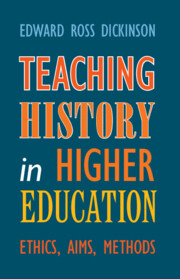Book contents
- Teaching History in Higher Education
- Teaching History in Higher Education
- Copyright page
- Contents
- Introduction
- Chapter 1 What Is History Like?
- Chapter 2 What Do Historians Do?
- Chapter 3 What Kinds of Stories Do Historians Tell?
- Chapter 4 What Kinds of Problems Do Historians Solve?
- Chapter 5 What Does History Teach Us?
- Chapter 6 Principles and Guidelines for Teaching History
- Bibliography
- Index
Chapter 3 - What Kinds of Stories Do Historians Tell?
Published online by Cambridge University Press: 07 February 2025
- Teaching History in Higher Education
- Teaching History in Higher Education
- Copyright page
- Contents
- Introduction
- Chapter 1 What Is History Like?
- Chapter 2 What Do Historians Do?
- Chapter 3 What Kinds of Stories Do Historians Tell?
- Chapter 4 What Kinds of Problems Do Historians Solve?
- Chapter 5 What Does History Teach Us?
- Chapter 6 Principles and Guidelines for Teaching History
- Bibliography
- Index
Summary
As a field of knowledge History is exceptionally interested in the particular and specific rather than the universal and general – it is primarily idiographic rather than nomothetic. It is also centrally concerned with change over time. These two characteristics make History fundamentally a storytelling discipline. Its findings are most often presented in narrative form. Of course, many books do not follow one narrative from cover to cover. But research findings are most often presented as stories – not as reports of particular key results (as, for example, in a scientific lab report) or as the results of statistical analysis. Nomothetic disciplines tend toward examining a relatively narrow set of features of multiple cases in order to create generalizing theories and establish laws of regularity that define what will happen under a given set of circumstances at any and all times and places. History instead usually aims to organize into a coherent interpretation many features of a single case, exploring in detail what happened at a particular time, in a particular place. It often also aims to give us a complex, multifactor causal explanation of why it happened as it did, but usually that causal explanation is embedded in the narrative.
- Type
- Chapter
- Information
- Teaching History in Higher EducationEthics, Aims, Methods, pp. 101 - 129Publisher: Cambridge University PressPrint publication year: 2025

